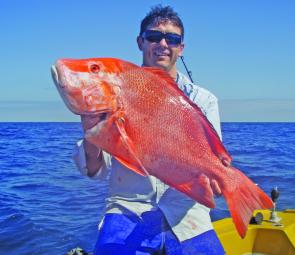Gladstone at this time of the year is hot and humid. That in itself means that the reef is the place to be in November.
Gladstone shoals are pretty easy to fish but I have to admit that it is difficult to target a particular species. It is more 'pot-luck-bottom-bashing'. So the challenge is to call the species before you see it. With a bit of experience you can identify the fish from the nature of the strike, the way it reacts to the battle, the strength and the nature of the run.
It is worth learning this technique before you choose to impress your mates.
On a recent trip to the Rock Cod Shoals, my mate Graham and I chose to drift across some of my usual hot spots. I have to admit I am little predictable with my plan of attack on the shoals. I usually head for the shallower shelf and then drift across the ledges. There are few large bommies on these shoals, so I generally don’t anchor up. There is little value unless you find a huge fish attractor.
Graham and I were being hit by small pickers, which is a common problem at Rock Cod. However, in the past it has only taken a few minutes for the larger fish to come onto the scene. But on this trip it took a while longer. First the iodine bream came in droves.
Iodine bream (or collared sea bream) are a much maligned fish where locals often screw their nose up at this species preferring to cut them up for bait. They do actually make great fresh bait and I have cut my share up for the sharp end of the hook. However, any bream of decent size, say 35cm or more, will end up in my ice box.
I have caught thousands of iodine bream and have never found one with the tell-tale iodine smell or taste. Apparently this comes about as the fish eats kelp containing iodine. This kelp is more common in colder climates so we may be spared from the iodine affecting many Gladstone specimens. And the fish I catch taste the same as any other bream species.
While iodine bream are not my favourite reef species, and I certainly wouldn’t count them in my bag limit, on a slow day they have at least improved the esky count.
Graham and I waited out the iodine bream onslaught. Then came the tuskfish and a few sweetlip. Both tuskers and sweetlip are my favourite reef eating fish, so the more we get in the esky the better.
On this trip, squid followed the tuskers to the boat and that’s when I pulled the squid jig from my arsenal. I keep a squid jig attached to a small folding telescopic rod and this weapon is within reach, particularly on these shoals. I have found that the squid often follow tuskfish to the boat but once I throw the jig in the water, they will instantly attack the jig. I have yet to have a squid release itself from the jig. So when a couple of squid came within sight, the jig was deployed and calamari came onto the menu.
This month will be a good time to check out the 12 Mile Reef areas. 12 Mile can be used as an en route location to either Rock Cod shoals or Masthead. There are a couple of larger size bommies on this reef area but the bite can be hot or cold here. If it is hot, you will catch heaps of XXL red emperor and some of the larger version of red throat. If it is not, you won’t even get a bite.
The wide reefs of Wistari, North West and Masthead are continuing to provide good catches and if you are capable of heading out that way, they will continue to be productive locations this month.
A good strategy which has often provided startling runs is to leave an unweighted bait floating from the back of the boat. Red throats will often rise to the bait and mackerel will make a swipe and will rip line from your reel faster than you can say, “You’re on!”
Mick Small was hit by a huge mackerel while doing just that at Wistari Reef. He was using a floating bait on a ganged 3-hook bait. It was a monster battle and produced a monster fish.
Masthead is still proving popular and this month hang around the lee side of the island for some good trout. Because of the larger structure, this is an area where you will need to anchor up. So find yourself a bommie, create a berley trail and hang on.
As the weather starts to warm, target the deeper holes around Middle Creek, Black Swan and Ramsay’s Crossing. Salmon will be good targets this month but not for much longer. Flathead will be moving along the drop-offs along the Narrows and the hunt for moving bait that tends to be more active during the warmer months.
Crabs will become more active along Grahams Creek in November. You may have to get in early to find a good location in any of the available drains.
Facts

Smallie needed some help to lift this Wistari Reef Spanish mackerel to the boat.

Rob Devlin was pleased with his red emperor caught while fishing the 12 Mile Reef.

Graham showing some of the bread-and-butter blue bone (tuskfish) he caught from Rock Cod shoals.




